Eduard Vallès
The exhibition dedicated to Antoni Fabrés by the Museu Nacional is in many ways a novelty. The most important of them is the fact that it is the first monographic exhibition dedicated to this artist in Catalonia.
The last one was held in one of the countries where Fabrés worked, Mexico, where he was the director of the Academy and the teacher of some of the great Mexican artists of the twentieth century. For example, in the Museu Nacional’s exhibition you can admire a portrait of a very young Diego Rivera, done by Fabrés when he was his teacher.
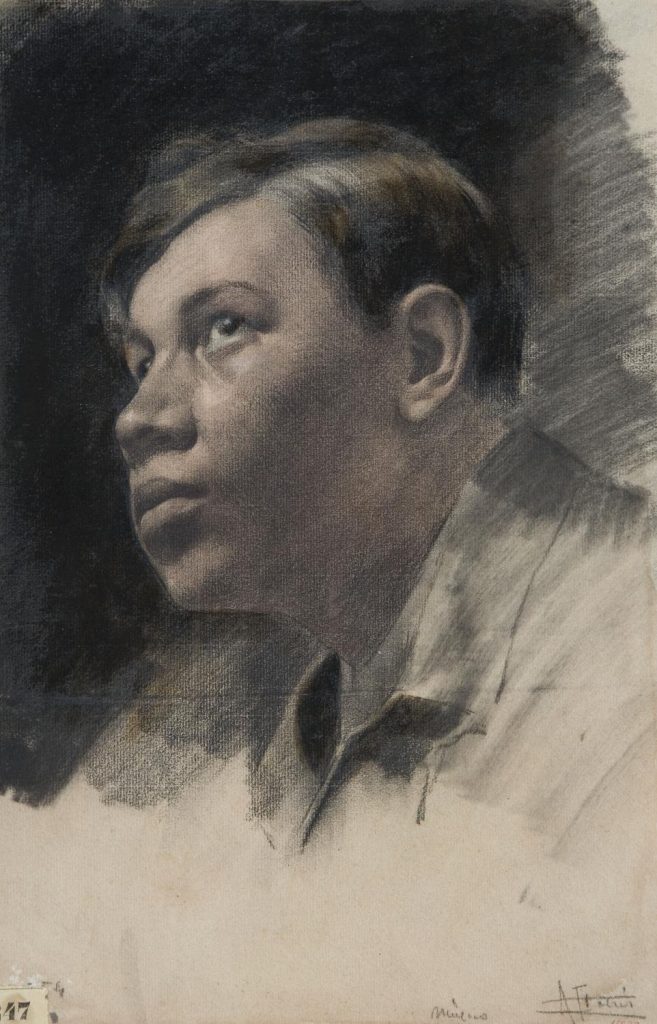
That Mexican Fabrés exhibition took place in 1994 at the Museo de San Carlos in Mexico City. Entitled Fabrés y su tiempo. 1854-1938 (Fabrés and his Time: 1854-1938), it included works loaned by the Museu Nacional. A catalogue of it was published that, together with the book Fabrés, by the lecturer Salvador Moreno (1981), also published in Mexico, were, until the complete monographic catalogue now published by the Museu Nacional, some of the most important bibliographical references with regard to this artist.
Una exposició i una monografia actualitzada i coral per a Antoni Fabrés
Antoni Fabrés i Costa. De la glòria a l’oblit (Antoni Fabrés i Costa: from Glory to Oblivion), the title of both the exhibition at the Museu Nacional and of the published monographic catalogue, has been curated by Aitor Quiney. The 285-page catalogue has texts by the curator himself and contributions by Francesc Fontbona, Francesc Quílez, Josep M. Domingo, Rosa Cabré and Carles Roig.
The exhibition gives a broad perspective of the life and work of this artist, who was not very well known, at least by the general public.
In this respect it has been useful, helping us to learn more about his life, very varied due to the different cities in which he lived – Rome, Barcelona, Mexico City and Paris – and also for the analysis of his artistic output, somewhat eclectic and difficult to fit into any artistic trends, and far removed from the ideas of the avant-garde.
Dazzled as he was by the work of Fortuny, his first trip to Rome undoubtedly had repercussions on his Orientalist work. But the shadow of Fortuny can also perhaps be sensed in the appearance of Fabrés’ workshops, crammed full of all kinds of the most unusual objects, like the wunderkammer, or curiosity cabinets, of the past that revealed the collector’s microcosm, while looking ahead to the future of museums.
The workshop as a metonym of the artist: Fabrés was without doubt one of the most singular cases in the history of Catalan art. Francesc Quílez, collections coordinator at the Museu Nacional, looks at this aspect in a researched article about Fabrés’ workshops in the exhibition catalogue.
This is one of the exhibitions that the museum dedicates to artists who, though they are not unknown, have never been exhibited retrospectively in Catalonia, or no monographic study has yet been made of them. This is the case with the publications dedicated to artists such as Pere Torné Esquius and Ramon Pichot, to mention two others in the same collection. These exhibitions, by definition, always involve a process of reviewing the life and work of the artist, and attributions are often altered, biographical details are changed. In short, progress is made in their study that, by definition, never ends – on the contrary, the thinking behind these exhibitions and their publications are a point of departure for future studies.
In search of an identity
This has occurred with one of the portraits by Fabrés in the exhibition, a large-format oil painting on canvas in the Museu Nacional. For years the sitter was identified as the painter from Tortosa Antoni Casanova Estorach.
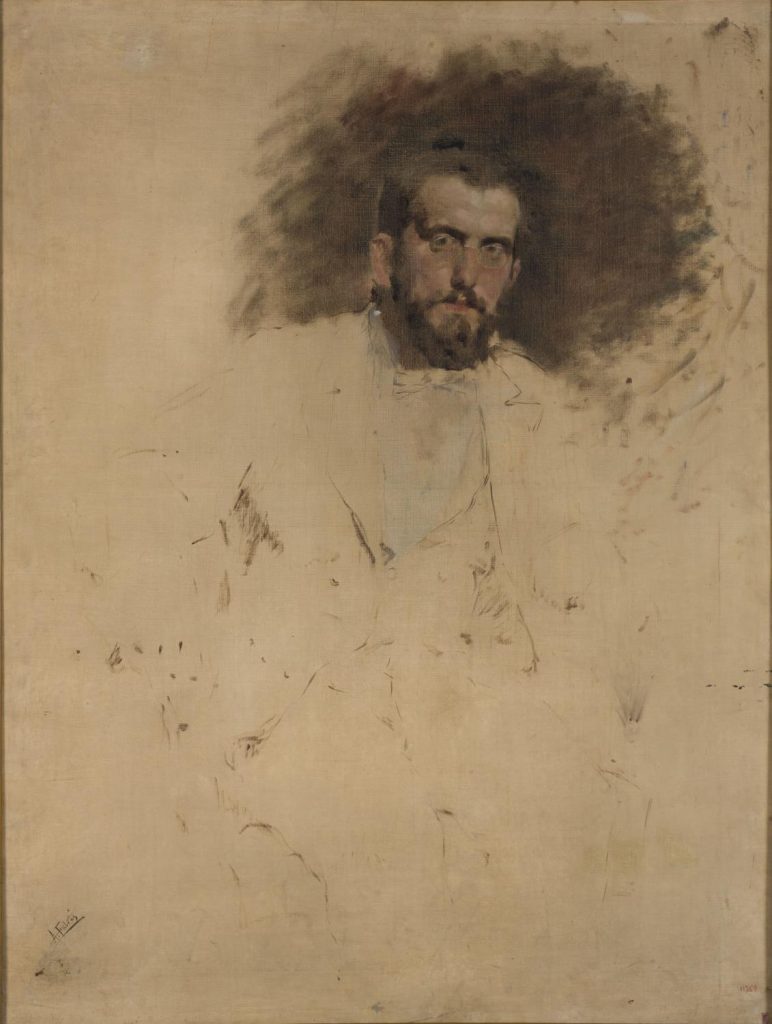
While researching the exhibition the curator Aitor Quiney identified it correctly. It is in actual fact a portrait of the painter — among many other things — Francesc Casanovas Gorchs.
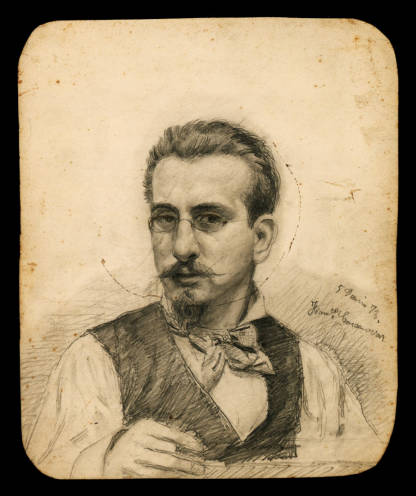
Apart from the fact that the sitter does not physically resemble Casanova Estorach, there is no proof that the two artists ever met. On the contrary, Casanovas Gorchs was a very close friend of Fabrés, for example in the years when the latter lived in Rome. During that stay, in 1880, Casanovas Gorchs did a portrait of Fabrés, to be precise a pencil sketch belonging to the Library of Catalonia, in which he catches him painting.
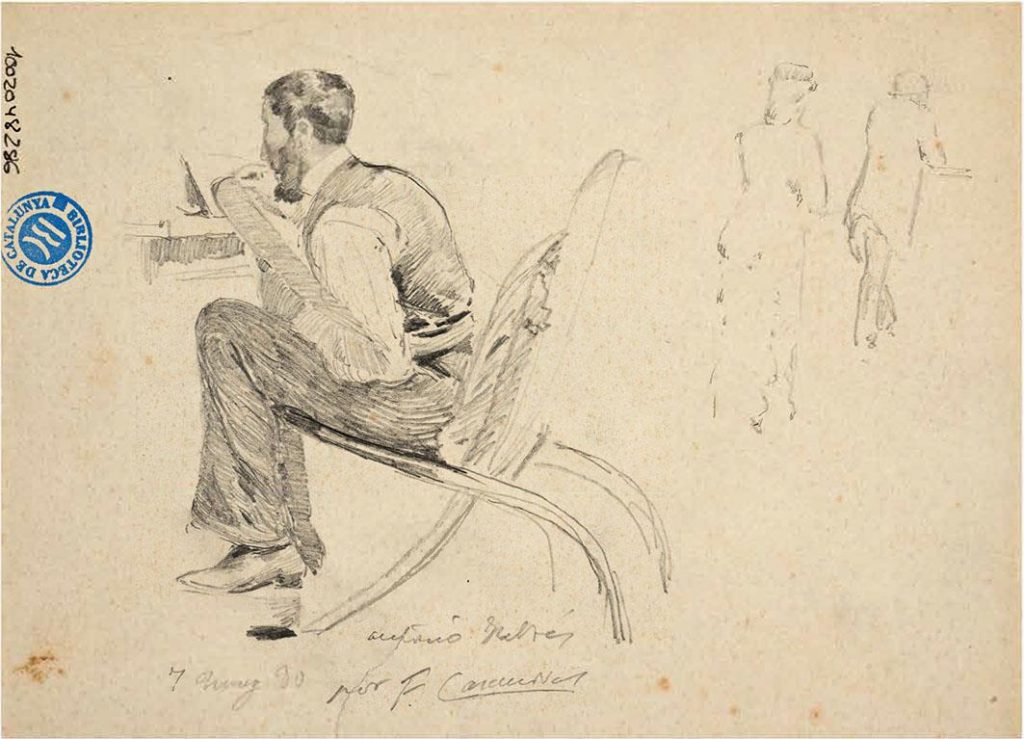
Fabrés in turn did the previously mentioned portrait of him, a very striking large-size canvas, of which the artist only uses part of the top half to paint his friend’s face. The body is lightly sketched and the rest of the canvas is left completely blank. Now that the sitter has been correctly identified, the question is: who was Francesc Casanovas Gorchs? Are there any works by him in the Museu Nacional? Has he been painted by any other artists, besides the portrait by Fabrés’?
Francesc Casanovas Gorchs: painter, author of comedies and opera singer
As an artist he is certainly little known, but he was actually someone with far wider interests. His biography is rather obscure, but the few details that are known show us a very interesting figure.
Besides being a painter Casanovas Gorchs was an illustrator, art critic, opera singer, artistic director and theatrical impresario. We are talking about someone with very diverse interests and registers, an unusual case not so much because of this diversity but because they are activities that by definition are not usually combined, although some cases are known.
Casanovas Gorchs, a més de pintor fou il·lustrador, crític d’art, cantant d’òpera, director artístic i empresari teatral. Estem parlant d’una personalitat amb interessos i registres molt diversos, un cas singular no tant per aquesta diversitat sinó per que són activitats que, tot i que se’n coneixen casos, per definició no acostumen a combinar-se.
He trained at the Llotja, at least in 1871-1872, and began a career as a painter, although for a few years he sang opera in Italian companies and he even wrote comedies. For example, in the same year, 1891, that he premiered one of his comedies, Mala jugada, he took part in the General Exhibition of Fine Arts in Barcelona with three works.
We also know that he worked as an illustrator in some publications and was an art critic in magazines like Álbum Salón or the newspaper La Publicidad. In Álbum Salón, in 1900 he published a short biography of his friend Fabrés. He also produced some publications on artistic themes, such as a book about the cathedral in Palma de Mallorca published in 1898, with illustrations by Casanovas and, once again, Fabrés. Casanovas Gorchs even sang at the Liceu and, according to Ràfols, he became its artistic director, although it seems he did other things as well in this institution. He was even its permanent impresario, according to Francesc Fontbona. His career as a painter was somewhat uneven, although he exhibited in different solo and group exhibitions; for example he put on solo exhibitions at the Sala Parés for several years.

The Museu Nacional has four works by him in its collections, a drawing and three oil paintings, one of them a self-portrait from 1910. It is in oils on canvas, donated by the artist himself, and it was shown in the exhibition Els autoretrats del Museu d’Art Modern (The Self-portraits in the Modern Museum), held in the Ciutadella Park building in 1983.
Casanovas Gorchs was also one of the figures portrayed by Ramon Casas in his famous iconographical gallery, a drawing that combines charcoal, wash, pastel and ink. Casanovas Gorchs appears full body, wearing a stiff hat, reading what looks like a newspaper, in a drawing owned by the Museu Nacional. The drawing would have been shown in the Casas exhibition at the Sala Parés in 1899 and, after that, it must have entered the municipal museums via Casas’ major donation in 1909.

Casanovas Gorchs also had his portrait painted by other artists, among them Joaquim Renart, with whom he worked in the Renart workshop of sumptuary arts. Among others, Renart painted the portrait of Casanovas Gorchs on his deathbed, in 1921, which appears in one of Renart’s sketchbooks that are also kept in the Library of Catalonia
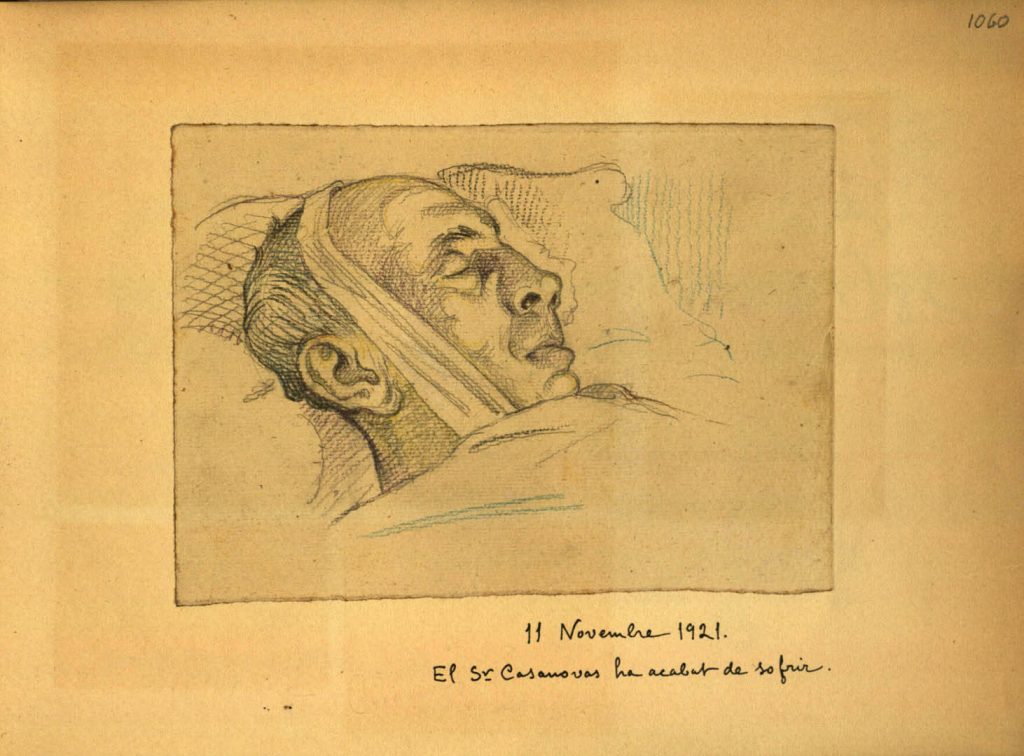
Some of the drawings by Casanovas Gorchs in the Library of Catalonia, together with a fantastic book of sketches that he did when he was singing opera in Italy, were exhibited in 1982 in the same library. It was to mark an exhibition curated by Francesc Fontbona, in which a hundred drawings and lithographs that are kept in that institution were exhibited. For that exhibition a catalogue was published with technical data of a hundred works and some illustrations, as well as a biography of Casanovas Gorchs written by Fontbona, the first biography but the most complete one to date. This publication provides us with information about one of the most interesting personalities on the Catalan artistic scene, with the term “artistic” understood here in its broadest sense.
Related links
Antoni Fabrés. De la glòria a l’oblit Exhibition catalogue
Francesc Casanovas. Biblioteca de Catalunya
Art modern i contemporani







